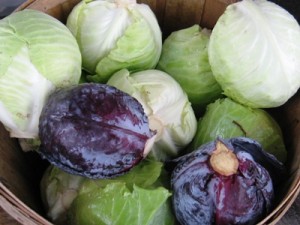 —that is the question:—
—that is the question:—
Whether ‘tis nobler in the mind to suffer
The bugs and weeds of outrageous (but typical) vegetable gardens,
Or to take arms against a sea of carrots imported from California,
And by growing our own end them?—to buy,—to sleep,—
No more; and by sleep to say we enjoy
Once again the gorgeous and scarce summer weekends
Instead of shelling peas, ‘tis a consummation
Devoutly to be wisht…
My thanks to William Shakespeare for allowing me to revise Hamlet’s soliloquy in support of my blog. If you’re wondering what happened to the blog this summer, I have two words for you: vegetable. garden. In mid-July I swore I would not be doing this again next year. I live in a part of the world in which I can get pretty decent fresh fruit and vegetables year-round, including a fair amount of locally grown and organic food. Home food production makes no sense at all, unless you are crazy or have lots of time on your hands. I made some calculations this summer to prove it:
Two people shelling peas calmly for two hours yields approximately 4 pints, an amount I could buy at Morning Glory, our natural foods store, for about $12, organic, frozen, available year-round, from Washington state. They taste good, too. That’s $3/hour for our labor, just for the shelling. It doesn’t include all the work and cost that happened before that: converting a hunk of field into good vegetable garden soil, buying seed, planting, weeding, watering, harvesting, boiling the water to blanch the peas, and making the ice to cool them down quickly before freezing them. Don’t forget the propane used to boil the water and the electricity used to make the ice and then to keep the peas frozen all winter.
And that is just the peas. Other food, such as tomatoes and peppers, get started from seed under a light, in February or March, with a heat mat under them, getting checked for moisture levels almost daily, then “hardened off” by taking them out during the day once frost is past and brought back in at night before you can actually plunk them down in the garden for good. Then they have to be watered daily until they have settled into their new home. There are also the vegetables that don’t make sense to freeze or can, such as potatoes. If you can get a root cellar put together—no small task—you then need to monitor the humidity and temperature all winter so your valuable produce doesn’t go bad.
Then there’s the issue of actually having the time to weed and deal with pests and pick and process the food. If you have a regular full-time job and you want to relax once in a while and enjoy the summertime life, either you work all the time at your second job (the Garden) or you let half or more of the food go by. Or you call up your non-crazy friends (the ones without gardens—why do I not have very many of those?) and get them to come over and pick their own. I roped my mother and her husband into actually WEEDING as part of the deal this year.
Of course, you couldn’t buy the TASTE of freshly-picked and shelled peas too easily, and it is utterly satisfying to make a meal with food you grew yourself. There’s also the whole political side of the story—take back your food production, go local, good for the environment, decrease dependence on petroleum products, and so on. Lots of people have written about this, including Barbara Kingsolver in Animal, Vegetable, Miracle where it sounds so romantic and just and where making your own cheese is like Julia Child whipping up the proverbial soufflé (actually, it is not that easy). And there are the apocalypse folks who believe that when our whole economic infrastructure goes to hell, you will be glad you have all of your food in the basement and seeds you saved from last year’s crop in the pantry. All good reasons to produce your own food, for sure, and I’m as enthralled as the next crazy gardener when it comes to watching gorgeous little pink and white beans turn into big, healthy plants full of beans that are also gorgeous AND delicious AND keep your belly full. I’m not jaded or bitter. I have been in love with that process since I started hanging around the UC Santa Cruz Farm and Garden Project in the early 90’s. Just for the record, I am not going to let my Maine Organic Farmers and Gardeners Association membership lapse. But is it really practical? And is it really worth the work and time? Maybe I’m trading one kind of healthy activity for another by weeding and canning and freezing instead of walking and kayaking and swimming. Producing your own food and relying on it can be fun, but it is also—at times—a serious, stressful business.
I have a neighbor who is 85, a tiny lady who still chops her own wood and likes to trade recipes for getting rid of tomato blight. I think she has the best take on the whole thing. She just smiles a little smile, shrugs and says, “Gardening is a disease I get every spring.”
I’m already thinking about what I’ll be growing next year.
Monday, Oct. 4, 2010